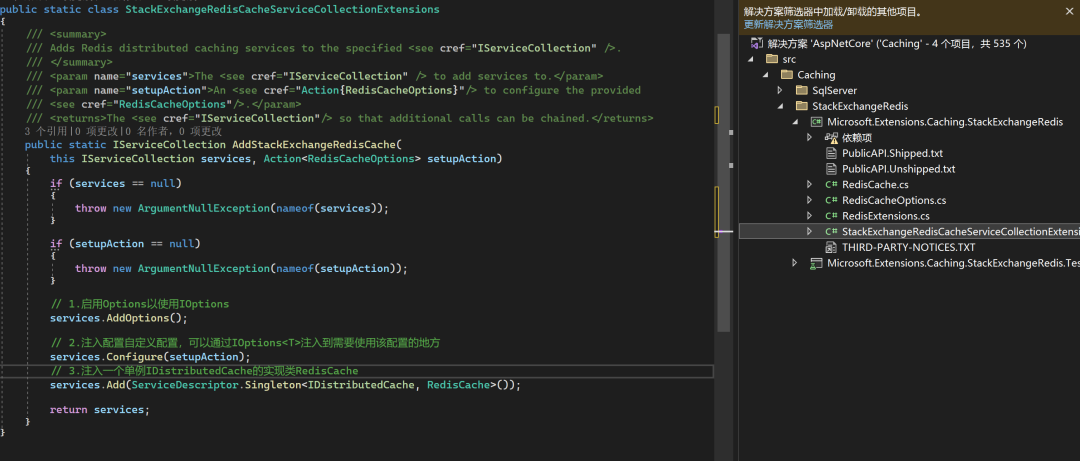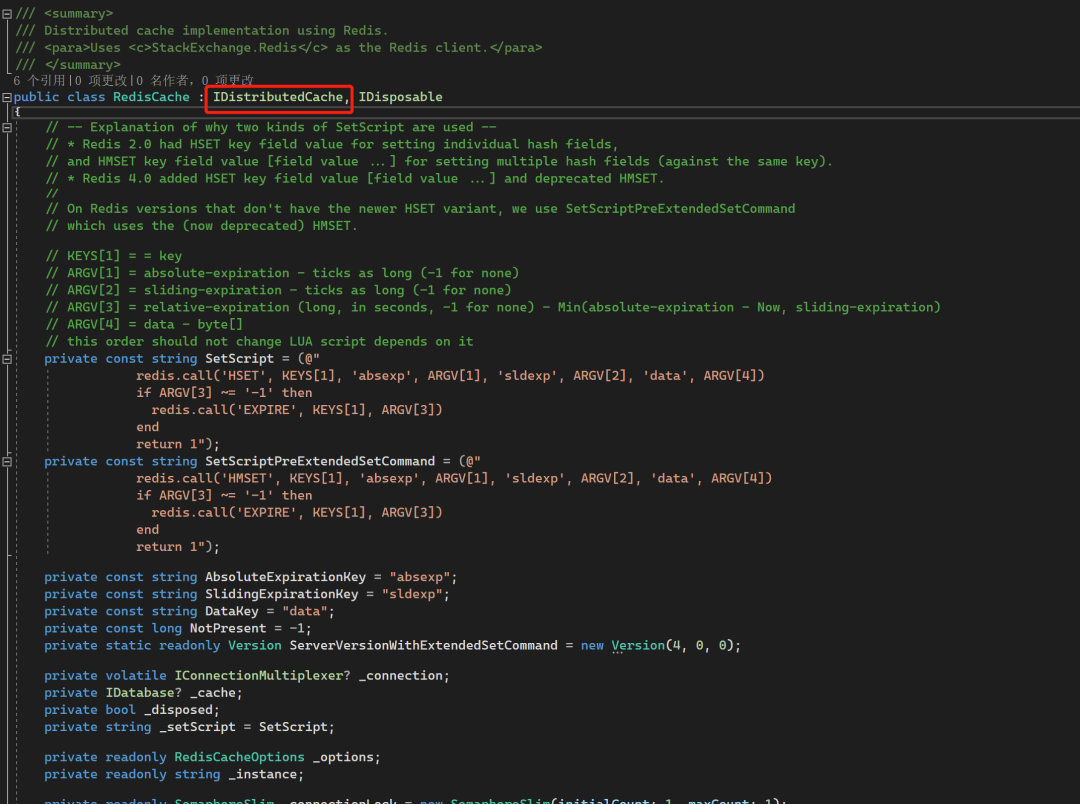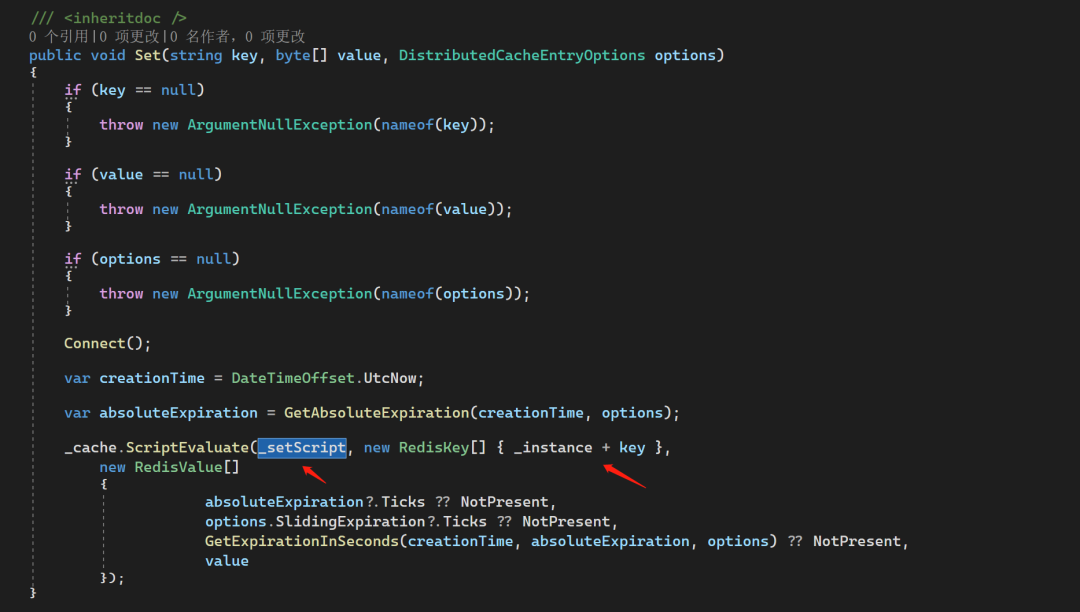前言
我们在项目中使用Redis时通常是写一个单例模式的RedisHelper静态类,暴露一些常用的Get、Set等操作,在需要使用地方直接RedisHelper.StringGet(xx,xx)就可以了,这样虽然简单粗暴地满足我们对Redis的所有操作需要,但是这在Asp.Net Core的项目显得不是那么优雅了。首先你的RedisHelper静态类无法使用Asp.Net Core容器,又如何优雅的通过依赖注入获取IConfiguration中的配置项呢?既然我们使用Asp.Net Core这么优秀的框架,最佳实践当然就是遵循官方建议的开发规范优雅的编写代码。
IDistributedCache
若要使用 SQL Server 分布式缓存,请添加对 Microsoft.Extensions.Caching.SqlServer 包的包引用。
若要使用 Redis 分布式缓存,请添加对 Microsoft.Extensions.Caching.StackExchangeRedis 包的包引用。
若要使用 NCache 分布式缓存,请添加对 NCache.Microsoft.Extensions.Caching.OpenSource 包的包引用。
无论选择哪种实现,应用都将使用
IDistributedCache接口与缓存进行交互。
来看下IDistributedCache这个接口的定义
namespace Microsoft.Extensions.Caching.Distributed;/// <summary>
/// Represents a distributed cache of serialized values.
/// </summary>
public interface IDistributedCache
{/// <summary>/// Gets a value with the given key./// </summary>byte[]? Get(string key);/// <summary>/// Gets a value with the given key./// </summary>Task<byte[]?> GetAsync(string key, CancellationToken token = default(CancellationToken));void Set(string key, byte[] value, DistributedCacheEntryOptions options);/// <summary>/// Sets the value with the given key./// </summary>Task SetAsync(string key, byte[] value, DistributedCacheEntryOptions options, CancellationToken token = default(CancellationToken));/// <summary>/// Refreshes a value in the cache based on its key, resetting its sliding expiration timeout (if any)./// </summary>void Refresh(string key);/// <summary>/// Refreshes a value in the cache based on its key, resetting its sliding expiration timeout (if any)./// </summary>Task RefreshAsync(string key, CancellationToken token = default(CancellationToken));/// <summary>/// Removes the value with the given key./// </summary>void Remove(string key);/// <summary>/// Removes the value with the given key./// </summary>Task RemoveAsync(string key, CancellationToken token = default(CancellationToken));
}IDistributedCache 接口提供以下方法来处理分布式缓存实现中的项:
Get、GetAsync:如果在缓存中找到,则接受字符串键并以 byte[] 数组的形式检索缓存项。Set、SetAsync:使用字符串键将项(作为 byte[] 数组)添加到缓存。Refresh、RefreshAsync:根据键刷新缓存中的项,重置其可调到期超时(如果有)。Remove、RemoveAsync:根据字符串键删除缓存项。
干掉RedisHelper
官方不仅提出了如何最佳实践分布式缓存的使用,还提供了基本的实现库给我们直接用,比如我们在项目中用Redis为我们提供缓存服务:
添加引用
Microsoft.Extensions.Caching.StackExchangeRedis注册容器
AddStackExchangeRedisCache,并配置参数
builder.Services.AddStackExchangeRedisCache(options =>{options.Configuration = builder.Configuration.GetConnectionString("MyRedisConStr");options.InstanceName = "SampleInstance";});在需要使用
Redis的地方通过构造函数注入IDistributedCache实例调用即可
这样就可以优雅的使用Redis了,更加符合Asp.Net Core的设计风格,养成通过容器注入的方式来调用我们的各种服务,而不是全局使用RedisHelper静态类,通过IOC的方式,结合面向接口开发,能方便的替换我们的实现类,统一由容器提供对象的创建,这种控制反转带来的好处只可意会不可言传,这里就不赘述了。
AddStackExchangeRedisCache到底干了什么
上面已经知道如何优雅的使用我们的Redis了,但是不看下源码就不知道底层实现,总是心里不踏实的。

源码比较好理解的,因为这个Nuget包的源码也就四个类,而上面注册容器的逻辑也比较简单AddStackExchangeRedisCache主要干的活
// 1.启用Options以使用IOptions
services.AddOptions();
// 2.注入配置自定义配置,可以通过IOptions<T>注入到需要使用该配置的地方
services.Configure(setupAction);
// 3.注入一个单例IDistributedCache的实现类RedisCache
services.Add(ServiceDescriptor.Singleton<IDistributedCache, RedisCache>());所以我们在需要用Redis的地方通过构造函数注入IDistributedCache,而它对应的实现就是RedisCache,那看下它的源码。
 这里就不细看所有的实现了,重点只需要知道它继承了
这里就不细看所有的实现了,重点只需要知道它继承了IDistributedCache就行了,通过AddStackExchangeRedisCache传入的ConnectionString,实现IDistributedCache的Get、Set、Refresh、Remove四个核心的方法,我相信这难不倒你,而它也就是干了这么多事情,只不过它的实现有点巧妙。 通过
通过LUA脚本和HSET数据结构实现,HashKey是我们传入的InstanceName+key,做了一层包装。
源码中还有需要注意的就是,我们要保证Redis连接对象IConnectionMultiplexer的单例,不能重复创建多个实例,这个想必在RedisHelper中也是要保证的,而且是通过lock来实现的。
然而微软不是那么用的,玩了个花样,注意下面的_connectionLock.Wait();:
private readonly SemaphoreSlim _connectionLock = new SemaphoreSlim(initialCount: 1, maxCount: 1);[MemberNotNull(nameof(_cache), nameof(_connection))]
private void Connect()
{CheckDisposed();if (_cache != null){Debug.Assert(_connection != null);return;}_connectionLock.Wait();try{if (_cache == null){if (_options.ConnectionMultiplexerFactory == null){if (_options.ConfigurationOptions is not null){_connection = ConnectionMultiplexer.Connect(_options.ConfigurationOptions);}else{_connection = ConnectionMultiplexer.Connect(_options.Configuration);}}else{_connection = _options.ConnectionMultiplexerFactory().GetAwaiter().GetResult();}PrepareConnection();_cache = _connection.GetDatabase();}}finally{_connectionLock.Release();}Debug.Assert(_connection != null);
}通过SemaphoreSlim限制同一时间只能有一个线程能访问_connectionLock.Wait();后面的代码。
学到装逼技巧+1
思考
IDistributedCache只有四个操作:Get、Set、Refresh、Remove,我们表示很希望跟着官方走,但这个接口过于简单,不能满足我的其他需求咋办?
比如我们需要调用 StackExchange.Redis封装的LockTake,LockRelease来实现分布式锁的功能,那该怎么通过注入IDistributedCache调用?我们可以理解官方上面是给我们做了示范,我们完全可以自己定义一个接口,比如:
public interface IDistributedCachePlus : IDistributedCache
{bool LockRelease(string key, byte[] value);bool LockTake(string key, byte[] value, TimeSpan expiry);
}继承IDistributedCache,对其接口进行增强,然后自己实现实现AddStackExchangeRedisCache的逻辑,我们不用官方给的实现,但是我们山寨官方的思路,实现任意标准的接口,满足我们业务。
services.Add(ServiceDescriptor.Singleton<IDistributedCachePlus, RedisCachePlus>());在需要使用缓存的地方通过构造函数注入IDistributedCachePlus。
总结
官方提供的IDistributedCache标准及其实现类库,能方便的实现我们对缓存的简单的需求,通过遵循官方的建议,我们干掉了RedisHelper,优雅的实现了分布式Redis缓存的使用,你觉得这样做是不是很优雅呢?

C#那么简单我为何之前还学C语言?)






从今天开始我是一个游戏开发者)







不会这个知识点代码越写越难)


